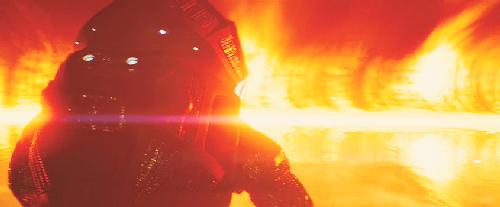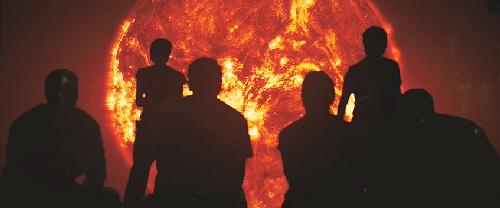Sunshine (Danny Boyle, 2007)
Danny Boyle’s Sunshine has a guaranteed cult following already. It’s a seriously intentioned, adult-oriented science fiction film, and these are few and far between. There’s a sector of the nerd audience out there that latches onto any science fiction film that moves even slightly beyond Star Wars style space pyrotechnics; this is a fan base that gets its regular sustenance from literary science fiction but which will eagerly devour the few scraps of “hard” sci-fi that Hollywood gives it. Sunshine, unfortunately, might need this fan base to keep it going. Boyle has made three quarters of a great film, but I suspect those not predisposed to enjoy this genre are going to struggle to forgive its flaws.
The film is very knowing about its sources. It is part of a venerable genre, what we might call the “deep space mission” films, in which a small crew face physical and / or metaphysical peril while far from Earth. This lineage includes classics such as Stanley Kubrick’s 2001 (the definitive in the genre), Andrei Tarkovsky’s Solaris, and Ridley Scott’s Alien, as well as a number of less celebrated examples such as Silent Running, Dark Star, Event Horizon, and Mission to Mars. In this case, our protagonists are a approaching the sun in their ship the Icarus 2, seeking to save the Earth by shooting a bomb into the dying star to re-ignite it. They go in the knowledge that the first attempt, by the crew of the original Icarus, failed for unknown reasons. Shortly after losing contact with Earth, they receive a distress signal from the lost ship and decide to investigate. And at that point, of course, things start to go awry.
It is one of the plot’s sillier details that a ship designed to fly close to the sun is called the Icarus: screenwriter Alex Garland presumably meant it as a subtle foreboding, but the mythology is too well known and it comes across instead as an incongruous joke, like having the “Oedipus Family Counselling Centre.” Yet for the most part the plot is put together with care and attention, without the lapses of credibility that tend to destroy films like this when somebody has dumbed them down (Mission to Mars leaps to mind as the textbook example). For example, the pivotal decision to divert course to investigate the original Icarus screams “bad idea” to any half-educated moviegoer, and could have had audiences hooting in derision, but the characters’ justification for doing so is reasonable. And as things start to go wrong, both the jeopardies they face and the solutions they employ are at first pretty credible, a reasonable extrapolation of the kind of real-life space crises we saw in Apollo 13.
Yet the film has higher ambitions than that: dominated as it is by the imagery of the ever-nearing sun it sort of has to. The quest to approach the sun has very strong spiritual and mythical overtones, and Garland introduces them early, showing the fascination the star is exerting on the crew. The psychological implications of approaching what is at once the source of all life, and the most long-held cultural symbol of divinity, are a recurring theme throughout the script. These aspects are brought out by really impressive visual effects. In this age where effects are becoming ever more overblown but also increasingly busy and ugly, it is rare that I would want to single out the special effects in a film for praise. Yet the visuals in Sunshine – done on a budget presumably a notch or two below the biggest Hollywood films – are notable for their beauty as well as their realism. They advance the plot and atmosphere of the film in much the same way the effects did in 2001, and it’s not a put-down at all to say that they are amongst the film’s great assets. One of my favourite moments in the film sees the crew gather together to watch Mercury pass across the sun; as they do so, the film has some of the same mix of wonder and dangerous mystery that distinguished the Jupiter sequences of Kubrick’s film.
The problem, though, is that while our space pioneers are heading into uncharted territory, Garland and Boyle are following very well tread paths indeed. There are only so many directions in which you can take a film in this genre. You can have the crew encounter a strange and otherworldly force (as in 2001, Solaris or Mission to Mars); or go the horror route and have them picked off by some kind of monster (as in Alien and Event Horizon); or perhaps you might explore how the stresses of space travel destroy the crew from within (as in Dark Star and Silent Running). In the end Boyle and Garland choose a little of all three, but can’t really take us anywhere we haven’t been before, and they lose some of the impact that any one of the possible resolutions could have had if pursued outright. The appearance of the mysterious “fifth crewmember,” for example, prompts some dialogue that makes a nod to the spiritual undertones of the story, but Boyle can’t draw out that aspect as clearly as he might like because he is also trying to build the menace of the intruder.
Indeed, as the final act resolves, Boyle uses just about every trick in the book of modern, jazzed-up action filmmaking to try to build excitement and horror. As he does so, he starts to lose his grip on the basic building blocks of his narrative, which until then had been admirably clear. Where is each character? What do they need to do? How soon must they do it? Boyle skimps on exposition and shoots with such shaky camera work that these basics become uncertain and the film becomes confusing. Boyle has had said the shoot was difficult, and these later scenes are sufficiently muddled that you feel he was editing the film together without some of the elements he needed: the fate of the Rose Byrne character, for example, is left up in the air for much of the climax in a way that suggests missing material more than a deliberate attempt at suspense.
It’s a shame, because so much of what precedes the climax is very good. The sci-fi cultists, in particular, will find a lot to like here, and the film will no doubt take its place on the long list of interesting-but-flawed attempts at science fiction for adults.

